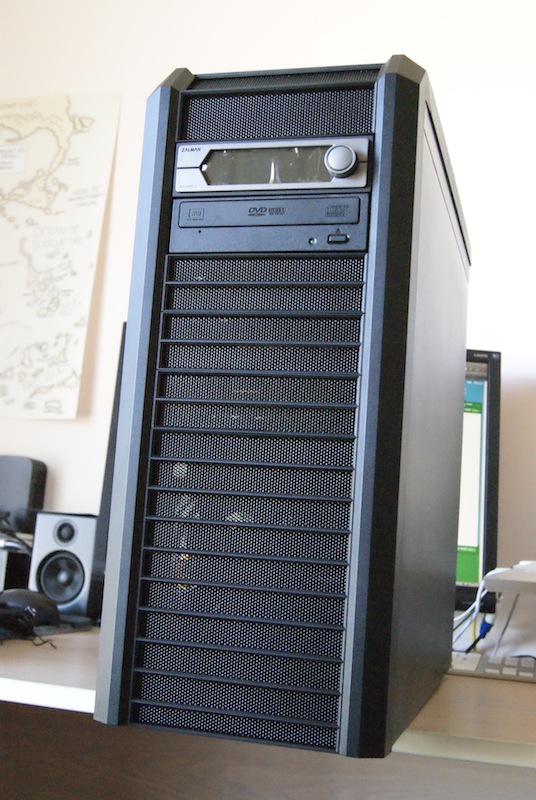So I told you a GTX 285 was going to arrive, and arrive it did.

Current setup is now the GTX 285 as the primary graphics card, and the GTX 260 (which I still haven’t decided what to do with – will probably sell it and use the proceeds towards an SSD) in PhysX.
Some numbers, if you would:
i7 2.8Ghz, GTX 260, 6GB 1600Mhz Dominators:
16290 3DMarks, CPU score: 4913.
3DMark Vantage Score: P11411, GPU: 9203, CPU: 40764.
11525 o3Marks (PhysX score)
285W under BC2
i7 2.8Ghz, GTX 285 (with GTX 260 in PhysX), 6GB 1600Mhz Dominators:
17279 3DMarks, CPU score: 4927
3DMark Vantage Score: P14374, GPU: 11816, CPU: 41004
14317 o3Marks (PhysX score)
360W under BC2, 230W idle.
Above are two sets – the one that has been quoted is what the system was before the GTX 285, and the one after is what results currently are. I’ll let you read into the numbers yourself, suffice to say Borderlands now runs at a stable 60FPS with everything on high @ 1920×1200, 16xAA etc, whereas before I was getting anywhere from 20-50FPS.
Couple of things (oh man, aren’t there always).
1. Gotta figure out what to do with the GTX 260. It’s still under warranty, works fine, and is by all respects, a brilliant little card (55nm, 216sp make it awesome). If I do sell it, I’ll be putting the money towards a SSD, either the OCZ Vertex or the Intel X-25M G2.
2. Remember that no-power-LED issue I had? It’s now fixed, courtesy of a little ingenuity by yours truly. At first I had issues trying to figure out why it would work in some configurations and not others (had I bothered to look at the manual I would have discovered the correct pin/wire combinations), but I figured it out eventually, and voila – a working power-on LED. It’s the small things.
3. New graphics card is HOT. Idles at around 45 degrees, under a pretty intense game of BC2 (again, 1920×1200, everything on high) it’ll get up to 85 pretty easily. FurMark pushes it to the limit, however – EVGA say this card is rated for 105 degrees, and I’ve hit 92 benching using FurMark. As a result of all this heat I’ve had to set up custom fan profiles in Rivatuner – which is a brilliant little program, I must say. So yeah – custom fan profiles. Anywhere from 20-54 degrees (idle temps) and the fan will be at a leisurely 60% speed. 55 to 64 and we go to 70%. 65 to 79 we go to 85% speed, and anywhere from 80 above we’re at 95%, or roughly 3200rpm. The fan is pretty bloody loud at anything above 80%, but I guess if it lengthens the lifespan of my GPU, then that’s an okay trade-off.

4. Look at the image above and tell me what’s wrong. Notice how the two GPUs are squished together? The intake fan of the GTX 285 (top) is completely blocked by the PCB of the GPU below it (the GTX 260). The thing is, if I want to run SLI on both 16x lanes this is the only choice I have. How do other people work around this? By running their top-of-the-line graphics cards in anything less than 16x/16x? Unacceptable.
The image at the top of this post shows how it’s currently setup (with the 260 in the bottom, 8x slot) – the GTS 285 has some breathing room, but if I wanted to SLI GTX 285’s, then I’d be in big trouble, and would have to get some serious air onto those graphics cards, ASAP.
Speaking of which – I’ve put a Scythe Kama Bay onto my wishlist. It’s just what I need to provide some much needed air to the GPU area, and with a 1900rpm Scythe Slipstream fan we’ll have some decent airflow around the middle of the case. I am unsure how I feel about having a case that doesn’t have any fan slots on it’s side panels, but eh – that’s okay, we can work with that.
Besides, how else would people see into my case with all it’s eye-dazzling blue LEDs? 😀


